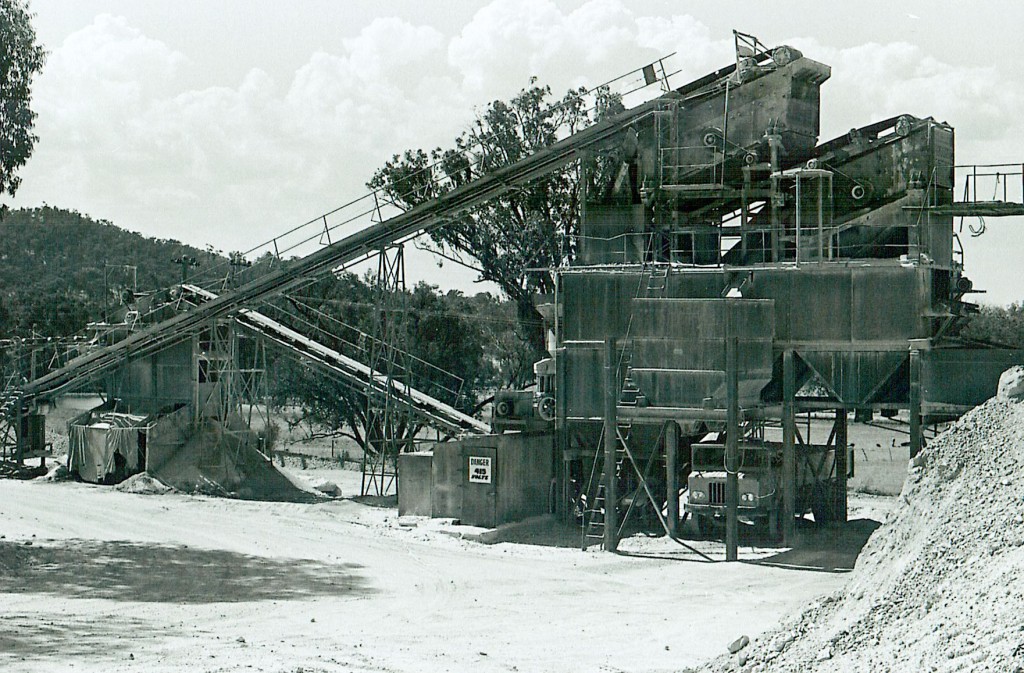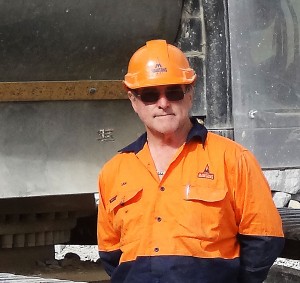E.B. Mawson & Sons Pty Ltd – Glenrowan Quarry

Extracts from Mawson’s Centenary Book, published in 2012 and reproduced below, provide some interesting
history on the Glenrowan Quarry.
Part of Australian folklore as the scene of Ned Kelly’s last stand, Glenrowan is also notable for its long quarrying history and its place as part of the Mawsons company.
Operating since 1890, the quarry was first developed to supply ballast for the Melbourne to Sydney railway. It became part of Mawsons when Glenrowan Quarry Company and Glenmix Pty Ltd was purchased from Rawsons in 1970. Glenrowan Quarries Pty Ltd was formed to purchase the assets of Glenrowan Quarry Co.
Peter Hobson, who went on to manage the quarry, started work at Glenrowan in 1957. He remembers the change of ownership well. “Ken [Mawson] and Hino [Hinz] took us into the office one by one and asked if we would stay or wanted to be paid out”. Peter recalls. “I said, I’ll give you a go.”
Some changes were immediate. “Mawsons certainly had plenty of money,” Peter says. “We were given a pretty easy hand here compared to the other companies. I went up to Albury one day and bought a big new welder. That made a huge difference.” There was also a different ethos.
“When Mawsons took over we became like a family,” Peter says. “Up until then we’d never had a Christmas party. When Mawsons came we all got close.” Big jobs soon followed. “Early on we won a contract for supplying quarry rock direct from the face for the Ovens River Improvement Trust from Wangaratta up to Bright,” he says. Praznovskys from Melbourne brought up about 15 trucks and Mawsons took over a motel in South Wangaratta for about six months and all the owner drivers worked from there. Our workshop serviced all the trucks at night.
“Another big job in 1975-76 was when Pioneer set up a big hot mix plant at our quarry for the main street of Wangaratta. We mixed here and supplied the stuff straight out of the heap.” Not everything was plain sailing. The quarry had some blasting issues, particularly with the cherry orchard next door. On one occasion, Evelyn Gow, who worked in the office, called Peter in distress. The orchardist had marched into the office with a large rock that had landed on his property. He dumped the rock on Peter’s desk and it crashed through to the floor.
One of the biggest jobs Mawsons ever did was the 25km Wangaratta Bypass in 1993. Unique in size and delivery method, it was the first ‘rock on ground’ project led my Mawsons, in a joint venture with Quarry Industries Ltd.
Mawsons supplied the source rock, did all the drilling, blasting and secondary breakage. About 5,000 tonnes or 200 truckloads, were carted to the bypass site every day. This work totalled about
700,000 tonnes for a year. The Glenrowan quarry also took care of all the dispatching, it was the first Mawsons quarry to have computerised weighbridge ticketing.
While all this was happening, the Mawsons Glenrowan team still had to service their regular customers. Jobs included other freeway work for VicRoads and work on the Newell Highway for the RTA. “We were running up to 17 trucks of our own plus 20 to 30 freeway contractors,” remembers Ossie Costello, who was manager at the time.
Mawsons demonstrated its reputation for innovation on several projects during this period, including helping to repair cracks at the base of the Hume Dam wall. Glenrowan crushed customised 40mm graded aggregate to go into the concrete for this project. Mawsons also developed frost-free crushed rock for VicRoads, a product still used on mountain roads today.
Present manager, Trevor Gilbert, explains that during his 10 years at Glenrowan the Wangaratta Shire’s population has increased by 10,000. This creates big demands for infrastructure. Another area of real growth for the quarry is supplying concrete aggregates. Ten years ago the quarry supplied two concrete plants. Now it supplies seven.
Large jobs undertaken in recent years include the upgrade work on the Buffalo Dam wall in 2003. Mawsons supplied all the rock for the transition layers of the dam. The quarry has also been kept
busy with flood rehabilitation work for the North East Catchment Management Authority and providing thousands of tonnes of rock to rehabilitate the washouts in regional rivers after the 2011 floods.
Business confidence is strong, reinforced by the extensive upgrade of the plant in 2012 which enabled production to increase significantly. The secondary plant has been upgraded with new crushers and new screens, replacing equipment that was over 50 years old.
Along with the hardness and durability of the Glenrowan stone, its unique colour is an attraction. “We get a lot of pink stone these days,” says regional marketing manager, Col Smith. “Now many Melbourne concrete plants and garden supply people come looking for nice coloured granite and the demand is increasing dramatically.”
A significant environmental step during the drought years was modifying the plant so all water was drawn from the quarry pit itself instead of town water – a big benefit for the quarry and the town.
Another key environmental measure was implemented in April 2012. The top bench of the quarry was battered off and ‘Aquaseeded’. The process involved spraying a mixture of paper pulp, water, glue, food dye and tree seeds native to the region, over the hill.
“With a bit of moisture, we’ll soon see the top of the hill start to regenerate.” Trever says, explaining he has received numerous calls from locals wanting to know what he has done to the quarry. Ned Kelly must be wondering too.
The Glenrowan Quarry continues to play an important role in supporting the building industry and broader communities of Victoria’s North East. A diverse range of products are crushed, screened and blended at Glenrowan which has access to Granite/ Granifier and Hornfels pits as well as providing a distribution base for Mawsons’ wide range of decorative River Gravels.
Glenrowan is currently delivering stone from 5 to 1000mm nominal size to dam projects in Beechworth and the Ovens Valley. This typifies the flexibility of the plant and its very competent operators and demonstrates the variety of work Mawsons undertake.
Mawson’s are constantly improving their plant and equipment to improve safety and efficiency and minimize environmental impacts. At Glenrowan upgrades to finished product storage facilities are currently underway and plans for a primary crusher upgrade are on the drawing board. People are Mawsons’ most valuable resource with development and training for the Glenrowan workforce being a constant.
E.B. Mawson and Sons Pty Ltd were founding members of the CMPA. Managing Director, John Mawson is on the CMPA Management Committee and believes that the Association has a critical role to play in educating industry operators and liaising with government. CMPA training plays an important role in developing Mawsons’ staff and helping to ensure that Mawsons’ plants operate safely and efficiently.

Old Site Photo: Glenrowan Tertiary crushing and screening plant 1970s.
60 Seconds with a voting member . . .
What is your name? Ian Dowell.
Who do you work for? E.B. Mawson & Sons Pty Ltd, Glenrowan Quarry.
How many years have you worked for this business? I have worked here for 15 years.
What is your role at the company? Excavator Operator/Rock Breaker.
Describe your average work day? Loading the dump truck for the primary crusher, breaking rock, relief loader operator.
What do you love about your work? I work with a great crew and a comfortable machine beats a big sledgehammer any day.
How many years have you been involved in the industry? 15 years.














You must be logged in to post a comment Login